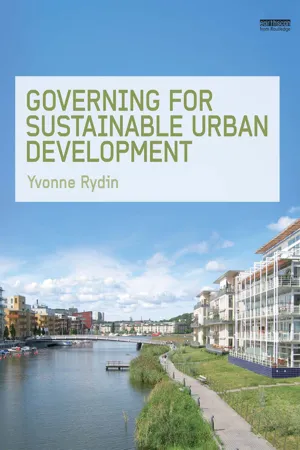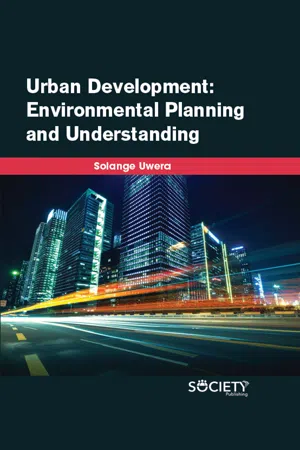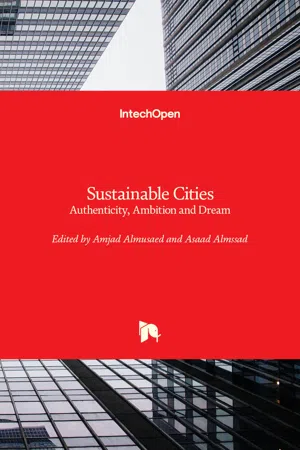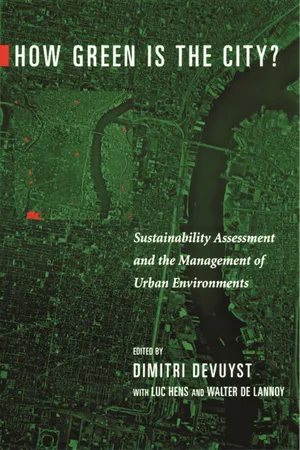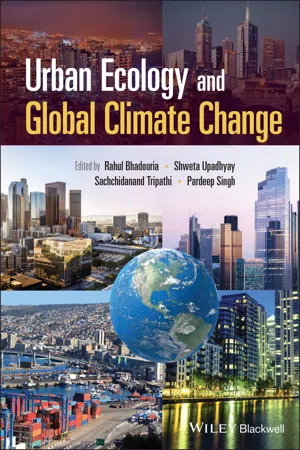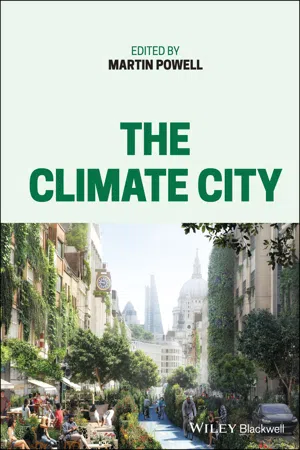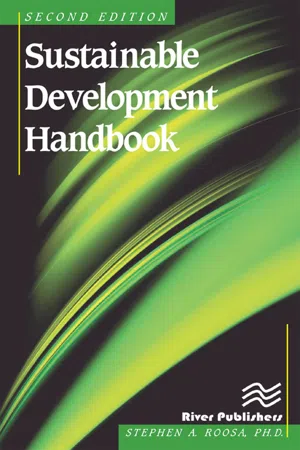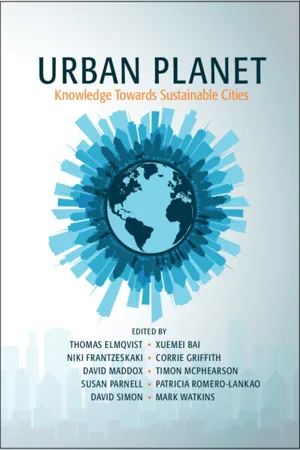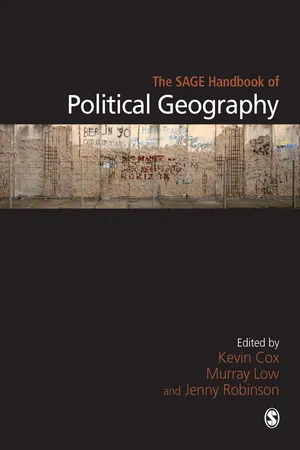Geography
Sustainable Urban Development
Sustainable urban development refers to the planning and management of cities in a way that meets the needs of the present without compromising the ability of future generations to meet their own needs. It involves creating cities that are environmentally friendly, socially inclusive, and economically viable. This approach aims to promote efficient land use, reduce pollution, and enhance quality of life for urban residents.
Written by Perlego with AI-assistance
Related key terms
1 of 5
11 Key excerpts on "Sustainable Urban Development"
- eBook - ePub
- Yvonne Rydin(Author)
- 2012(Publication Date)
- Routledge(Publisher)
1 Sustainable Development and the Urban Agenda IntroductionSustainable development is now widely acknowledged to be an important policy goal, possibly the most important policy goal. This curious and not always well-understood mix of environmental protection, sustained economic activity and social welfare has become the public face of much policy activity. Its profile has been raised by the continuing and growing evidence of the scale and significance of climate change, by the enduring nature of profound social inequalities and even by the reversal of economic fortunes as economies slide into recession.Sustainable development offers the prospect of a very different world and this includes our urban areas, our towns and cities and the built environments that they comprise. Urban areas are central to all aspects of sustainable development. They are centres of economic wealth-creation and yet, at the same time, locations of social deprivation. They can be associated with all sorts of environmental degradation – loss of green space, air pollution, greenhouse gas emissions linked to energy use, waste generation and excessive water consumption to name but a few key aspects – and yet offer the scope for considerable resource efficiencies.This raises the prospects of changing our urban areas to contribute more fully to sustainable development rather than undermine it. Change can, of course, occur within the existing physical fabric but there has been increasing interest in using the processes of urban development to drive change. Understood broadly, urban development can encompass new build, demolition and rebuild, refurbishment, regeneration and area improvement. These all have considerable potential for reshaping the built environments of urban areas.This book looks at the role that urban development can play in delivering sustainable development. It considers how activity at the urban scale is related to the broader concept of sustainable development (the remainder of Chapter 1 ) and elaborates what Sustainable Urban Development means at the scale of the building, the development site, and the urban area or region (Chapter 2 ). After an account of the market processes that drive urban development (Chapter 3 ), the main emphasis of the book is on how processes of governing can shape the delivery of Sustainable Urban Development. Chapters 4 and 5 - eBook - PDF
Urban Development
Environmental Planning and Understanding
- Solange Uwera(Author)
- 2019(Publication Date)
- Society Publishing(Publisher)
It cannot be seen as a goal but rather as a never-ending journey.” Therefore, manageability for any undertaking and activity identified with social, ecological, and financial ought to be included with its predefined attributes as far as its spatial, worldly, and topical settings are concerned (Olsson, 2009). 1.4. URBAN SUSTAINABILITY In urban points of view, Sustainable Urban Development concerns the basic information inputs and yields from an urban framework. Sustainability has turned into a key planning objective in urban development since the sustainable development assertion by the International Union for the Conservation of Nature and Natural Resources (IUCN), the United Nations Environment Program (UNEP), and the World Wildlife Fund in 1980, and the declaration with respect to sustainable urban areas in the Toronto Declaration on World Cities and Their Environment in 1990 (Lin and Yang, 2006). A sustainable city is characterized as a city planned with considerations for the environment, with least utilization of energy, water, and food and least yield of waste and air, water, and soil contaminations. Urban sustainability can likewise be characterized as the development of the personal satisfaction of individuals inside the limit of Environment’s constrained resources (Figure 1.4). Thus, urban sustainability is the capacity of urban communities to decrease the natural impact of urban exercises while improving social value and decency in urban territories (Newman and Kenworthy, 1999; Chiu, 2008; Van Wee and Handy, 2016). Urban Development: A Global Perspective 9 Figure 1.4: Urban development at Greengate. Source: www.geograph.org.uk Also, urban sustainability endeavors to manage the topic of how societies develop and run their urban frameworks to guarantee the preconditions of development for who and what is to come. Accordingly, finding how occupants can be instructed and take part in building up a quality situation is imperative (Nurul, 2015). - eBook - PDF
Sustainable Cities
Authenticity, Ambition and Dream
- Amjad Almusaed, Asaad Almssad, Amjad Almusaed, Asaad Almssad(Authors)
- 2019(Publication Date)
- IntechOpen(Publisher)
That way, high-quality service can be deliv -ered in the most cost-effective way. In a long-term economic focus that embraces social and environmental factors, there are often much more significant gains to be anticipated for the benefit of both business and society in general. In other words, there may be growth and jobs in social and green sustainability as well as an export potential in sustainable urban solutions. 4. Recommendation For a future arrangement of sustainable cities, the new urban agenda, adopted in Quito (Ecuador) on October 17, 2016, complements the 17 sustainable development goals assumed Introductory Chapter: Overview of Sustainable Cities, Theory and Practices http://dx.doi.org/10.5772/intechopen.82632 11 by world leaders at the end of 2015 through Agenda 2030 for Sustainable Development. The Strategic Vision of Sustainable Urbanization, negotiated for more than 3 years and presented at the Conference on Housing and Sustainable Urban Development (Habitat III), provides for a comprehensive approach to urbanization for the next 20 years. Thus, the Sustainable Urban Development agenda proposed by UNDP is focused on concrete actions and sets global stan -dards for Sustainable Urban Development. It also includes a series of recommendations cen -tered on rethinking how people will build, manage and live in cities by 2036 [5]. The economic and environmental footprint of urban centers is very high, despite the fact that they only cover a small part of the globe (0.51% of total land area globally). In terms of percentages, cities accounted for over 80% of world GDP in 2014, producing more than 70% of global greenhouse gas emissions and 80% overall energy consumption. At the same time, experts estimate that in 20–30 years the development of urban centers will be significant, tripling in size and reaching about 1.2 million square kilometers in 2030. - eBook - PDF
- Ronan Paddison(Author)
- 2000(Publication Date)
- SAGE Publications Ltd(Publisher)
All this has far-reaching consequences for urban science and environmental planning. In a condition of relative demographic and economic equilibrium between city and countryside, the destiny of cities depends heavily upon the quality of their own physical lay-out, internal functioning and equilibrium between the built and the natural environment. In a condition of imbalance, on the contrary, their destiny depends upon the develop-ment process that is happening outside them; any policy intervention on urban assets is destined to amplify the perceived disparity in the develop-ment potential between the city and the 136 Handbook of Urban Studies countryside, fostering cumulative immigration processes that annihilate the potential effects of the initial intervention (Lo, 1992). Consequently, in developing countries, policies addressed to the sustainable development of big cities should be complemented in parallel by: • policies focused on a balanced regional devel-opment, and in particular policies for the development of rural areas; • policies focused on the construction of a balanced urban system, based on a creative, country-specific blending of the traditional hierarchical pattern of centres and the modern network pattern of specialized centres (Camagni, 1992; Camagni, 1994). 8.7. URBAN SUSTAINABILITY PRINCIPLES AND POLICY IMPLICATIONS As mentioned above, the strict application of urban sustainability requires a focus on the economic, social and environmental aspects of urban life (cf. Newman and Thornley, 1994). This calls usually also for a strict urban energy conservation policy (see Banister, 1996b; Newman and Kenworthy, 1989, 1991). In many cases, targets and critical limits for various aspects (indicators) of urban sustainability have to be specified (for example, noise level, CO 2 levels, density, traffic etc.). - eBook - PDF
How Green Is the City?
Sustainability Assessment and the Management of Urban Environments
- Luc Hens, Walter De Lannoy, Dimitri Devuyst(Authors)
- 2001(Publication Date)
- Columbia University Press(Publisher)
The commission defined sustainable development as meeting the needs of the present without compromising the ability of future generations to meet their own needs (WCED 1987). This simple, but vague definition was also the foundation for Agenda 21, the document that emerged from the United Nations Conference on Environment and Development (also known as the “Earth Summit” held in 1992 in Brazil) as a sustainable development action plan for the 21st century (Voisey et al . 1996). From Concept to Practice Practitioners who turned to these paradigms or movements for direction in applying these concepts to the communities where they work and live have found much inspiration but relatively little guidance. Only recently has there been rapidly growing interest in the practical application of these ideas at the local level. In the last few years literature has appeared that begins to support this practical application of ideas. Even more than the paradigms discussed above, this new literature reflects a somewhat bewildering variety of orienta-tions and terminology. The authors include architects, academics, and activ- THE ECO-CITY APPROACH TO SUSTAINABLE DEVELOPMENT IN URBAN AREAS 93 ists, and the terminology includes everything from “neotraditional town planning”“ and “pedestrian pockets” to “reurbanization,” “post-industrial suburbs,” and “sustainable cities.” To help the reader navigate this new applied literature, I have organized it (see Table 3-1) into four broad categories which reflect the backgrounds, world views, or orientations of the various authors: Designers, Practitioners, Visionaries, and Activists. [13] The Designers category includes the literature on the costs of sprawl and sustainability by design. These authors are, for the most part, architects, planners, consultants, and related professionals. - eBook - PDF
- Rahul Bhadouria, Shweta Upadhyay, Sachchidanand Tripathi, Pardeep Singh(Authors)
- 2022(Publication Date)
- Wiley-Blackwell(Publisher)
However, every factor has its own role to play, but public participation and private–public partnerships are essential keys of the framework, which could be more impactful with various awareness campaigns, setting of short-term goals and targets, incentivised completions, and progresses (Stafford-Smith et al. 2017). 15.4.1 Sustainable Cities It has been concluded from various studies and surveys that urbanisation is a major aspect for sustainable development and that the process of urbanisation could be a blessing if it is controlled, regulated, and planned, but in its contrast, it could prove to be curse for human society if it would become uncontrolled, unplanned, and unregulated (Mohan et al. 2011; Liu et al. 2011; Shen et al. 2012; Roders 2013). The UN 2010 report defined urbanisation as the mobilisation of people from rural to urban areas termed as urban migration is found to be the most predominant trend of the twenty-first century. The rapid increase in urbanisa-tion occurs due to many attractive benefits such as jobs, education, market efficiency, improved health, better lifestyle, and raised living standards. But all these benefits come at the cost of air, food and water pollution, depletion of cultivated land, global warming, cli-mate change, and others (Dye 2008; Liu et al. 2011; United Nations 2010). The UN report (2010) estimated the rise in urban populations from 13% in 1900 to 29% in 1950 to 50% in 2009 and projected to be 69% in 2050. Therefore, making the cities or the urban centres more sustainable could be the best remedy in order to achieve SDGs as well as to fight against prime issues such as socioeconomic inequality, climate change, pollu-tion, ecological imbalance, and degradation of nature and natural resources. The whole discussion will give rise to another term, i.e. sustainable urbanisation, which needs a holis-tic approach that includes broad perspectives of economic, social, political, demographic, and environmental performances. - eBook - PDF
- Martin Powell(Author)
- 2022(Publication Date)
- Wiley-Blackwell(Publisher)
Research across Organisation for Economic Co-operation and Development (OECD) countries found that well-function- ing and well-managed cities are central to all the fundamental aspects of people’s well- being and sustainable development, from water to housing, transport, infrastructure, land-use, and climate change, among others. As UN-Habitat observes, the inclusion of a dedicated cities goal (SDG 11) is a strong recognition by the international community 13 UN Secretary General, 2018. Progress on the implementation of the New Urban Agenda. https:// digitallibrary.un.org/record/1628008?ln=en. 14 https://www.oecd.org/regional/regional-policy/Governing-the-City-Policy-Highlights.pdf. Sustainable Development Won’t Happen if it Doesn’t Happen in Cities 83 Figure 4.6 Cities’ share of the pie. (Source: Author derived from C40 city data. https://www.c40.org/.) Figure 4.5 Rocinha slum, one of the biggest in Brazil. (Source: Donatas Dabravolskas/Adobe Stock.) 4 The Sustainable City 84 that urbanization is a transformative force for development that not only links to all other SDGs, but also underpins them. Figure 4.8 shows the indicators for progress against SDG 11. But making the SDGs a reality in cities – and, correspondingly, leveraging cities’ role in addressing the interlinked “wicked problems” of climate change, poverty, and inequality – will become even more complex as urban populations swell. For instance, energy demand is forecast to triple in line with urban growth over the next few decades, along with an equivalent demand for vital resources including water and food, as well as the need for housing, jobs, faster and better communications, and transport, placing ever more pressure on land and adding to already complex challenges and debates over land- use. Today, just 1.5% of the world’s land is home to half of its production. - eBook - PDF
Sustainable Development as a Civilizational Revolution
A Multidisciplinary Approach to the Challenges of the 21st Century
- Artur Pawlowski(Author)
- 2011(Publication Date)
- CRC Press(Publisher)
• Providing cheaper accommodation space. • Protecting children against the hazards typical of cities. • The need for peace and quiet. The listed expectations have their ecological dimension (contact with nature), economic dimension (cheaper accommodation space), and also social dimension (sense of security, escape from the hustle and bustle of city life). Moreover, one can point to the low population density in rural areas. This prompts the development of strong social relations; everybody knows each other, no one is anonymous. Things look different in the case of cities. Here, the population is very dense, and the social relations are not as strong as in the country (related to, for example, the high level of anonymity). Proper, and hence, sustainable, urban environment management is a major challenge in this context. Table 28 presents the classic definitions on this matter. The discussion was expanded within the last few years. Wojciech Peski (1999) perceives such management as an activity directed at securing the effi-cient operation and sustainable development of a historically shaped settlement. This general statement is then fleshed out in more detail by indicating the pri-mary objectives of such development: • To increase the income of both the city and its residents. • To increase employment. • To support actions directed at increasing the level of a city’s economic self-reliance. • To support actions directed at improving the state of the environment (Peski, 1999). These tasks and needs must be realized in such a way as not to impair the future generation’s ability to meet their needs—which is a direct reference to sustainable development. Such an approach expands the discussion by environ-mental and social aspects. The concepts of ‘ecological cities’ also goes in this direction (Bithas & Christofakis, 2006). - Stephen A. Roosa(Author)
- 2020(Publication Date)
- River Publishers(Publisher)
Effects include adverse environmental im-pacts, dislocation of populations, and changes in urban infrastructure. The broad issues concerning cities and the manner in which their policies di-rectly and indirectly impact urban energy use will be explored. 1 2 Sustainable Development Handbook Sustainable development is a theoretical construct. After all, sustain-ability within the time frame of the human experience on Earth, may be difficult if not impossible to achieve. Therefore, using the concept of sus-tainability as a catch-all solution for all global problems is fraught with peril. According to Harken (1993:211), “Most global problems cannot be solved globally because they are global symptoms of local problems with roots in reductionist thinking that goes back to the scientific revolution and the beginnings of industrialism.” This reality does nothing to diminish the importance of sustainable development. Many aspects of the concept of sustainability have problem-solving implications for industry, institutions, corporations, and govern-ments. Most often, sustainability becomes defined more by the policies that are deployed and the agendas that these policies establish. To compli-cate the difficulties in implementing the agenda, understand that sustain-ability has far-reaching and universal implications. Sustainability is about resources, management policies, energy, social concerns, planning, eco-nomics, environmental impacts, construction practices, and much more. Responding to its agenda has caused institutions to rethink basic process-es, with the potential of yielding fresh and creative solutions to current problems. Understanding sustainability is a complex task. Berke believes that sustainability may be the next paradigm or “framework to dramatically shift the practice of local participation from dominance by narrow spe-cial interests toward a more holistic and inclusive view” (Berke 2002:23).- eBook - PDF
Urban Planet
Knowledge towards Sustainable Cities
- Thomas Elmqvist, Xuemei Bai, Niki Frantzeskaki, Corrie Griffith, David Maddox, Timon McPhearson, Susan Parnell, Patricia Romero-Lankao, David Simon, Mark Watkins(Authors)
- 2018(Publication Date)
- Cambridge University Press(Publisher)
It can help governments and citizens alike understand the far-reaching impacts of urban form, so that they can engage in the planning process more meaningfully (Rudd et al. 2017). In so doing, they can address a number of crit- ical questions: Where should development be located? Which pattern(s) will 7 http://newsroom.unfccc.int/unfccc-newsroom/finale-cop21/ 186 Part II: Global Urban Sustainable Development it embody? How will it balance process and outcome to yield both social and environmental sustainability? Target 11.7 responds to research that shows public and green space disap- pearing in unplanned cities. At the same time, existing public space in planned cities is being commercialized, exacerbating socioeconomic fragmentation (UN-Habitat 2013, 2015). Both situations are weakening cities’ capacities to provide basic services equitably and efficiently, suggesting the need for both a qualitative and quantitative approach: cities, particularly fast-growing ones, should first secure an adequate proportion of public space; additionally, cit- ies can take measures to improve the amenities, accessibility, greenness, and safety of existing public space. Scholars and practitioners are left with crucial open questions, such as: How can policy-makers optimally use the informa- tion provided by geospatial technology? How to best influence the norms that regulate the private ownership of land? SDG 11 also acknowledges cities as developmental drivers beyond their administrative boundaries. The goal’s promotion of urban-rural linkages (Target 11.a) signals a reinvigorated desire from the international community to move from a dichotomous conception of urban and rural development to one of mutually reinforcing, synergistic development across the rural-urban continuum. However, such a concept remains quite difficult to translate into tangible policies at all levels of government. - eBook - PDF
- Kevin R Cox, Murray Low, Jennifer Robinson, Kevin R Cox, Murray Low, Jennifer Robinson(Authors)
- 2007(Publication Date)
- SAGE Publications Ltd(Publisher)
Any consideration of the future for sustainable development policy and politics will need to take on board that the development of gov-ernance processes must be part of a broader politics arguing the need for change. REFERENCES Agyeman, J., Bullard, R. and Evans, B. (2001) Just Sus-tainabilities: Development in an Unequal World . London: Earthscan. Amin, A. and Thrift, N.J. (eds) (1994) Globalization, Institu-tions and Regional Development in Europe . Oxford: Oxford University Press. Chambers, N., Simmons, C. and Wackernagel, M. (2000) Shar-ing Nature’s Interest: Using Ecological Footprints as an Indicator of Sustainability . London: Earthscan. Daly, H.E. (1992) Steady-State Economics. London: Earthscan. Gouldson, A. and Murphy, J. (1998) Regulatory Realities. London: Earthscan. Hall, P. and Taylor, R. (1996) ‘Political science and the three new institutionalisms’, Political Studies , XLIV: 936–57. Harvey, D. (1996) Justice, Nature and the Geography of Difference . Oxford: Blackwell. Independent Commission on International Development Issues (ICIDI) (1980) North–South: A Programme for Survival . London: Pan Books. International Union for the Conservation of Nature (IUCN) (1980) World Conservation Strategy . Gland, Switzerland: IUCN. Jacobs, J. (1991) The Green Economy . London: Pluto Press. Kern, K. and Löffelsend, T. (2004) ‘Sustainable development in the Baltic Sea region. Governance beyond the nation state’, Local Environment , 9(5): 451–68. Lafferty, W. (2001) Sustainable Communities in Europe . London: Earthscan. LASALA Project Team (2001) Accelerating Local Sustainability – Evaluating European Local Agenda 21 Processes , Vol. 1. Freiburg, Germany: ICLEI. Levett, R. (1998) ‘Sustainability indicators: integrating quality of life and environmental protection’, Journal of the Royal Statistical Society , 161(3): 291–302. Lundqvist, L. (2004) ‘Integrating Swedish water resource management: a multi-level governance trilemma’, Local Environment , 9(5): 413–24.
Index pages curate the most relevant extracts from our library of academic textbooks. They’ve been created using an in-house natural language model (NLM), each adding context and meaning to key research topics.
